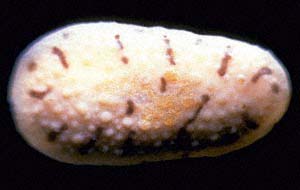
Phyllidia zebrina
Baba, 1976
Order: NUDIBRANCHIA
Suborder: DORIDINA
Family: Phyllidiidae
DISTRIBUTION
Sagami Bay, Japan.
PHOTO
60 m depth, Amadaiba, Sagami Bay, Japan, Preserved holotype, 14 mm, Photo: K. Baba (Brunckhorst, 1993: Plate 3B).
This species was described from a single preserved animal which was not dissected. Based on a colour sketch of the living animal its external colour is described as being yellowish white with a number of short black stripes arranged as in the accompanying photo. The anus is in the posterior dorsal midline and the mantle is covered with small rounded tubercles.
Unlike Phyllidia varicosa and Phyllidia coelestis, there are no dorsal ridges. Phyllidia flava is yellow, but it completely lacks any black pigmentation. Phyllidia ocellata and P. loricata have large black rings or spots, not fine black lines like those of P. zebrina.
NOTE: See Soichi Matsukawa's photos and subsequent discussion on relationship between this species and Fryeria larryi.
Reference:
• Baba, K. (1976) Record of Phyllidia zebrina n. sp. from Sagami Bay, Japan (Nudibranchia: Doridoidea: Phyllidiidae). Venus, The Japanese Journal of Malacology, 35(1) 5-8. ([In Japanese])
• Brunckhorst, D.J. (1993) The systematics and phylogeny of Phyllidiid Nudibranchs (Doridoidea). Records of the Australian Museum, Supplement 16: 1-107.
Rudman, W.B., 2003 (May 29) Phyllidia zebrina Baba, 1976. [In] Sea Slug Forum. Australian Museum, Sydney. Available from http://www.seaslugforum.net/find/phylzebr
Related messages
Re: Phyllidia zebrina or Fryeria larryi?
May 31, 2003
From: Nishina Masayoshi
Dear Bill,
Today, my colleague J. Imamoto found our animal on the Forum as Fryeria larryi Brunckhorst, 1993 so it is a puzzle.
Nishina Masayoshi
nishina@wips.co.jp
Masayoshi, N., 2003 (May 31) Re: Phyllidia zebrina or Fryeria larryi?. [Message in] Sea Slug Forum. Australian Museum, Sydney. Available from http://www.seaslugforum.net/find/10115Dear Nishina,
I should have considered Fryeria larryi as a possibility, but just accepted Dave Brunckhorst's identification of your photo. However, I'm afraid its not that simple as you animal has features of both 'species'. The basic problem is that both species were described from single specimens, and in neither case was the anatomy studied. All we know is that in P. zebrina the anus opens on a dorsal papilla while in F. larryi it opens ventrally. I tend to agree that your animal looks more like F. larryi because it doesn't show the rounded tubercles on the mantle of P. zebrina. However it is white like P. zebrina rather than yellow like the sole known specimen of F. larryi. The sole specimen of P. zebrina was 14mm long preserved, and of F. larryi, 6mm long.
I am afraid this is another example of the problems of describing and naming new species from single specimens. I can't even say that the position of the anus is a good character to use in separating these two species because, as we discuss elsewhere on the Forum, there is evidence to suggest that in some species at least, the position of the anus is variable.
All I can suggest is that we leave your animal with Phyllidia zebrina until we get more specimens or photos.
Best wishes,
Bill Rudman
Phyllidia zebrina from Japan
May 30, 2003
From: Nishina Masayoshi
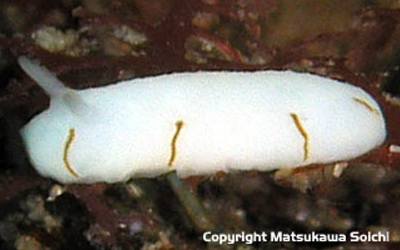
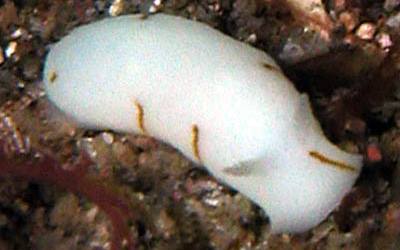
Dear Bill,
Soichi Matsukawa has sent me these photos of an animal he saw which we think is Phyllidia zebrina. I have emailed David Brunckhorst who agrees with our identification. I was glad to hear this because we could not find any information on the living animal of this species since Baba described it a long time ago.
Location: Osezaki beach, Suruga Bay, Pacific coast of Japan 35" 00' 00"0 N; 138" 45' 00"0 E.
Depth:-25m
W/T: 20C degree.
Length: 7mm
May 2003
Photo: Soichi Matsukawa
Thank you very much for your comment.
Best Regards,
Nishina Masayoshi
nishina@wips.co.jp
Masayoshi, N., 2003 (May 30) Phyllidia zebrina from Japan. [Message in] Sea Slug Forum. Australian Museum, Sydney. Available from http://www.seaslugforum.net/find/10079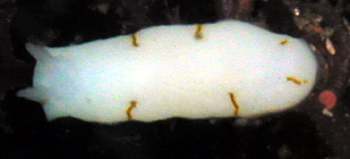
Dear Nishina & Soichi,
Thanks for these interesting photos. I think it is the first record since Baba's original description. Baba's colour description was based on a colour sketch so its possible that the black lines he described were actually brown, as in your animal, rather than black. Or perhaps the colour varies from brown to black. It is of course possible that this brown lined animal is another species. Baba also described the noticeable rounded tubercles all over the mantle in his species. I can't see them in Soichi's photos, but perhaps they are not obvious is smaller animals. I know it will sound greedy, but it would be nice to find some more specimens.
Best wishes,
Bill Rudman
'Phyllidia zebrina' from South Africa
January 11, 2001
From: Valda Fraser
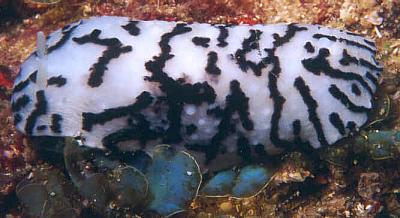
Dear Bill
A black and white beauty, but who is it? Hope you'll be able to solve the problem. This nudibranch was given to me to photograph by a friend, Martin Wallace.
Locality: Pumula, south coast KwaZulu-Natal, SOUTH AFRICA, 45m
Date: Dec 2000
Size: 50mm
Regards
Valda Fraser
valdafraser@mweb.co.za
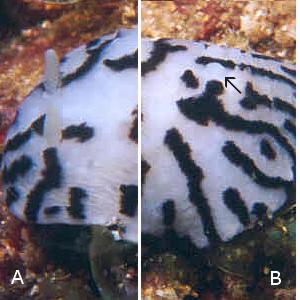
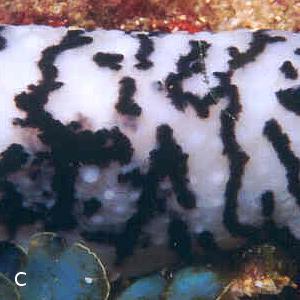
Dear Valda,
This is another wonderful find. The only thing it reminds me of is Phyllidia zebrina which was described from one preserved animal from Japan. I must say if it does turn out to be the same then it much more appropriate having zebrina from Africa than from Japan.
If you look at the photo of the preserved Japanese specimen at the top of the page you will see it has a very similar colour pattern. Also it was described as having low tubercles over the body which you can see clearly in your photo (PHOTO C) and the anus opens on a small papillae which I have arrowed in PHOTO B.
In all main features then it matches Phyllidia zebrina. The problems with this identification is that Japan is a long way from South Africa and we have no records from anywhere in between. There is also no anatomical information to compare. Finally we don't know what genus "Phyllidia" zebrina really belongs in.
All things considered you have found something very interesting, I suspect it is the same as Baba's P. zebrina but we have a lot of work to do before we can be sure.
Best wishes,
Bill Rudman
